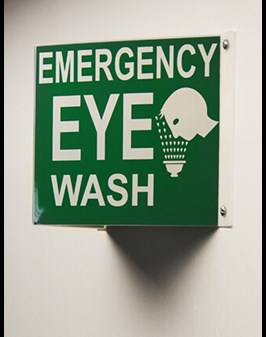OSHA and ANSI Safety Colors

What's the first thing you think of when you imagine a red sign? The odds are good that you picture an octagon-shaped "Stop" sign or a triangular "yield" sign.
We all associate certain colors with specific uses, so it's no surprise OSHA and ANSI have identified a number of safety colors for consistency among visual communication in workplaces throughout the United States.
OSHA and Safety Colors
OSHA outlines two broad requirements for safety colors in its standard for safety color codes (29 CFR 1910.144). The standard maintains that red and yellow must be used for marking physical hazards.
- Red must be used for fire-related hazards, as well as emergency switches, bars, and buttons on hazardous machines. ("Fire-related hazards" may include identifying fire protection equipment and containers of flammable liquids.)
- Yellow indicates caution and is used for physical hazards, including striking against, stumbling, falling, tripping, and "caught in between."
ANSI and Safety Colors
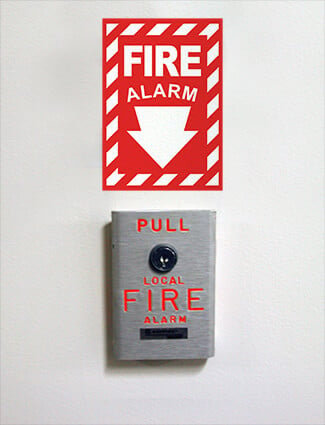 ANSI has outlined 10 safety colors for visual communication-and specific applications for each-in the ANSI Z535 safety sign standard. The standard dictates every aspect of sign design, including standard colors and signal words (such as "Danger" and "Caution").
ANSI has outlined 10 safety colors for visual communication-and specific applications for each-in the ANSI Z535 safety sign standard. The standard dictates every aspect of sign design, including standard colors and signal words (such as "Danger" and "Caution").
At right is a quick look at the most common colors, what each communicates, and where to use them.
ANSI Safety Color: Red
Red is universally recognized for identifying the most serious hazards, as well as fire hazards and fire equipment. Safety signs that comply with the ANSI Z535 standard use red for "Danger" signs and labels that warn when death or serious injury is almost certain to occur if the hazard is not avoided.
In addition to "Danger" signs, here are other scenarios where red should be used:
- Fire safety items, including fire extinguishers and fire alarms
- Emergency stop switches, buttons, and bars on machinery
- Containers carrying flammable liquid
- Confined space hazards
- Construction hazards and PPE requirements
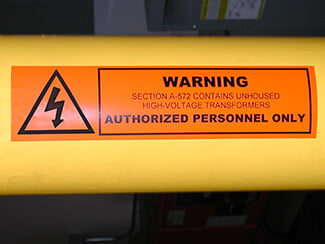 ANSI Safety Color: Orange
ANSI Safety Color: Orange
Orange identifies dangerous machines or equipment that may crush, cut, shock, or injure workers in other ways. Orange is used on "Warning" signs and labels when a hazard may result in death or serious injury, but when the overall risk isn't severe enough for a "Danger" sign.
The following scenarios may call for orange signs and labels:
- Exposed and moving machine parts
- Low clearance levels
- Electrical hazards (such as high voltage or potential static)
- Most work zone markings (including safety cones and barrels)
- Road construction signs
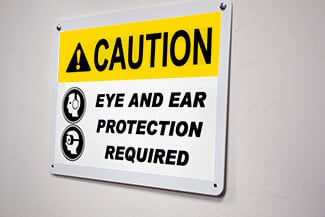 ANSI Safety Color: Yellow
ANSI Safety Color: Yellow
Much like the OSHA standard for safety colors, ANSI recognizes yellow as a color for communicating hazards that may lead to worker injuries if not avoided. Most commonly, these signs warn against unsafe practices.
Here are a few situations where yellow signs and labels should be used:
- Instruct workers to wear PPE while working on certain machines or when in a specific area
- Point out common hazards, such as wet floors
- Inform employees when entering a construction area, or where only authorized employees are allowed
- Alert employees to exposed edges of loading docks, platforms, and curbs
- Warn workers of moving equipment, overhead hazards, and other physical hazards
ANSI Safety Color: Green
Green is reserved for general safety signs, which offer safety-related messages that don't touch on specific workplace hazards.
Green signs should:
- Point out first aid kits, emergency eye wash fountains, and other medical equipment
- Offer general sanitation guidelines and reminders
- Encourage employees to report accidents, unsafe conditions, and other incidents
- Motivate employees to be mindful of general hazards
- Suggest best practices and other safety measures
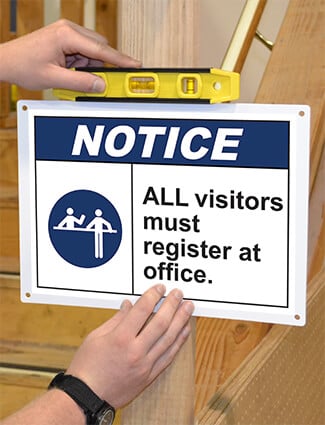 ANSI Safety Color: Blue
ANSI Safety Color: Blue
Blue communicates information unrelated to personal injuries and other hazards (most commonly on "Notice" signs). It is most commonly associated with maintenance work and other safety precautions.
Blue signs may:
- Alert employees to designated smoking and non-smoking areas
- Remind employees of best work practices
- Communicate procedures, information, instructions, and rules for maintenance
- Share the overhead clearance in a given area
Safety Colors ? Labels and Signs
Learn the basics behind effective visual communication with Duralabel Best Practice Guide to OSHA Safety Signs. The free resource explains the relevant OSHA and ANSI standards, breaks down the different sign classifications, and helps employers create safety signs specific to their workplace needs. Download below.
Related Resources

Pipe Makers & Pipe Labels | Piple Marking Labels
Workplaces are safer than ever, but challenges remain: In 2014, nearly three million nonfatal workplace ...
Read
OSHA and Workplace Safety: A Right for Every Worker
The U.S. Bureau of Labor Statistics (BLS)shared its workplace fatality statistics for 2022. The bureau ...
Read
Pipe Marking & Pipe Corrosion Control
The Silver Eagle Refinery explosion released a tidal wave of broken glass. Homes were pushed off their ...
Read.png)
